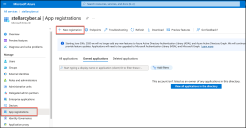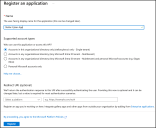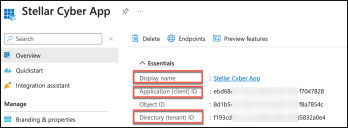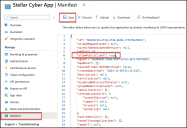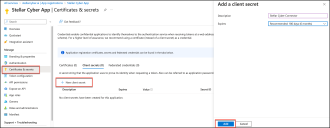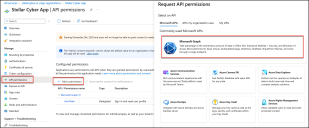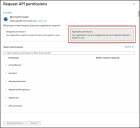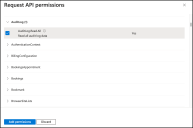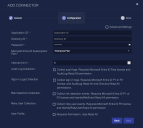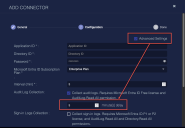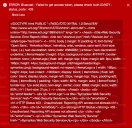Configuring Microsoft Entra ID (formerly Azure Active Directory) Connectors

This connector allows Stellar Cyber to collect data from external sources and add the records to the data lake and, optionally, to issue response actions.
Microsoft Entra ID (formerly Azure Active Directory) integration with Stellar Cyber provides advanced identity and access management capabilities, enabling organizations to manage user access and security policies across their network, and providing enhanced security controls and compliance features.
The user information from Microsoft Entra ID (formerly Azure AD) enriches event Interflow records and provides user profile details for User Behavior Analytics. You can also disable (and re-enable) users for applicable events, and confirm a compromised user and dismiss the risk of a user.
If you have more than one Microsoft Entra ID, you must create one connector for each of them.
Stellar Cyber connectors with the Collect function (collectors) may skip collecting some data when the ingestion volume is large, which potentially can lead to data loss. This can happen when the processing capacity of the collector is exceeded.
Connector Overview: Microsoft Entra ID
Capabilities
-
Collect: Yes
-
Respond: Yes
-
Native Alerts Mapped: Yes
-
Runs on: DP
-
Interval: Configurable
Collected Data
|
Content Type |
Index |
Locating Records |
|---|---|---|
|
Audit Log Collection Sign-in Logs Collection Risk Detection Collection Risky User Collection User Profile |
Windows Events |
Domain
|
https://graph.microsoft.com/ |
Response Actions
|
Action |
Required Fields |
||||||||||||||||||
|---|---|---|---|---|---|---|---|---|---|---|---|---|---|---|---|---|---|---|---|
|
The Disable User action requires User.EnableDisableAccount.All and User.ReadWrite.All permissions. |
|||||||||||||||||||
|
The conditions for creating the Confirm Compromised and Dismiss Risk actions are as follows:
The Confirm Compromised and Dismiss Risk actions use the riskyUsers API, which requires an Microsoft Entra ID P2 license and IdentityRiskyUser.ReadWrite.All permissions. |
|||||||||||||||||||
There are two other ways to disable the Microsoft Entra ID user:
-
Navigate to Respond | Actions and choose the User Actions tab. See Create a Disable User Action.
-
Navigate to Investigate | User Behavior Analytics and choose the Users tab. See Disable a User Action.
Third Party Native Alert Integration Details
This connector can ingest several log types, but only Risk Detection logs are relevant to alert mapping.
For details, see Integration of Third Party Native Alerts.
Required Credentials
-
Application (client) ID, Directory (tenant) ID, Secret Key (password)
Let us know if you find the above overview useful.
Adding the Microsoft Entra ID Connector
To add the Microsoft Entra ID connector:
- Register an application
- Configure the application
- Add the connector in Stellar Cyber
- Test the connector
- Verify ingestion
Registering an Application
Follow the instructions below to register an application and configure Microsoft Entra ID portal. During the process, make note of the following values for use when you create the connector later:
-
Application (client) ID
-
Directory (tenant) ID
-
Secret Key (password)
-
With an administrative account, log in to the portal you use for Microsoft Entra ID administration of the Microsoft subscription (tenant) in which you want to register the Stellar Cyber application. (Example portals are: https://go.microsoft.com, portal.azure.com, and https://admin.microsoft.com/adminportal). If your account gives you access to more than one tenant, select your account icon and then the Microsoft Entra ID tenant that you want.
The Dashboard appears.
-
Select Microsoft Entra ID from the left navigation pane.
-
In navigation pane, select App registrations. A pane for adding and managing App registrations is displayed.
-
Click New registration. A pane is opened for your new parameters.
-
Enter a Name.
-
Choose a supported account type. Accounts in this organizational directory only is typical.
-
The Redirect URI setting is not required.
-
Click Register. The registration is created and a summary of it is displayed.
-
Copy the following details to a file:
-
Display Name
-
Application (client) ID
-
Directory (tenant) ID
-
You are now ready to configure the application.
Configuring the Application
-
To set the access to the application, in the navigation pane, select Manifest.
-
In the manifest editor, locate the field for allowPublicClient and ensure it is set to true.
-
Save the manifest changes.
-
-
To create your secret key, in the navigation pane, select Certificates & secrets.
-
To set the permissions for your application, in the navigation pane, select API Permissions. The API permissions pane appears.
-
Click Add a permission. The Request API permissions pane appears.
-
Click Microsoft Graph. The pane updates to offer Delegated permissions or Application permissions.
-
Click Application permissions.
The pane updates to display options for setting permissions.
-
Set the following permissions for the logs you want to collect.
Logs API Permission License Required Audit AuditLog.Read.All Microsoft Entra ID Free Sign in AuditLog.Read.All Directory.Read.All
Microsoft Entra ID P1 or P2 Risk detection security reports IdentityRiskEvent.Read.All Microsoft Entra ID P1 or P2 Risky user security reports IdentityRiskyUser.Read.All Microsoft Entra ID P2 User profile User.Read.All None -
Click Add permissions. The API permissions page redisplays with your added permissions.
-
If you are the super admin, grant the permissions. Select the checkmark to Grant admin consent for <account name>.
Otherwise, wait for the super admin to grant them.
Make sure that the permissions are granted. If you add the connector before permissions are granted, the process fails.
When the permissions are granted successfully, there will be a green checkmark in the Status column.
-
-
If your connector will be used for respond actions, the API must also be configured with application permissions. From the API Permissions pane, click Add a permission again.
-
In the Request API permissions pane, click Microsoft Graph.
-
Click Application permissions.
-
For the Disable User response action, enable User.EnableDisableAccount.All and User.ReadWrite.All. For the Confirm Compromised and Dismiss Risk response actions, enable IdentityRiskyUser.ReadWrite.All.
-
Click Add permissions. The API permissions page re-displays with your added permissions.
-
The permissions can take up to two hours to propagate to historical data. We suggest you add the permissions at least two hours prior to adding the connector in Stellar Cyber, as Stellar Cyber will try to pull historical logs when first configured.
Adding the Connector in Stellar Cyber
With the application registered, permissions granted, and the access information handy, you can add the Microsoft Entra ID connector in Stellar Cyber:
-
Log in to Stellar Cyber.
-
Click System | Integration | Connectors. The Connector Overview appears.
-
Click Create. The General tab of the Add Connector screen appears. The information on this tab cannot be changed after you add the connector.
The asterisk (*) indicates a required field.
-
Choose SaaS from the Category drop-down.
-
Choose Microsoft Entra ID (formerly Azure Active Directory) from the Type drop-down.
-
For Function, enable the Collect checkbox. If you would like to issue response actions, also enable Respond.
-
Enter a Name.
This field does not accept multibyte characters.
-
Choose a Tenant Name. The Interflow records created by this connector include this tenant name.
-
Choose the device on which to run the connector.
-
(Optional) When the Function is Collect, you can create Log Filters. For information, see Managing Log Filters.

-
Click Next. The Configuration tab appears.
The asterisk (*) indicates a required field.
-
Enter the Application ID you copied earlier.
-
Enter the Directory ID you copied earlier.
-
Enter the Password you copied earlier.
-
Select the applicable Microsoft Entra ID Subscription Plan from the menu:

-
Enterprise Plan
-
GCC Government Plan
-
GCC High Government Plan
-
DoD Government Plan
To learn about Microsoft Entra ID government plans, refer to the following Microsoft documentation: https://learn.microsoft.com/en-us/azure/security/fundamentals/feature-availability.
-
-
Choose the Interval (min). This is how often the logs are collected.
-
Choose the logs you want to collect. These must match the permissions you set in Microsoft Entra ID. None are collected by default, so you must select at least one log. Note the following:
Log
Required License
Required Permissions
Alert Integration
Audit Log
Microsoft Entra ID Free
AuditLog.Read.All
No
Sign-in Logs
Microsoft Entra ID P1 or P2
AuditLog.Read.All
Directory.Read.All
No
Risk Detection
Microsoft Entra ID P1 or P2
Identity.RiskEvent.Read.All
Risky User
Microsoft Entra ID P2
Identity.RiskyUser.Read.All
User Profile
N/A
User.Read.All
No
-
(Optional) Stellar Cyber allows you to customize the scope of the request the collector should request for the selected log type. For example, specifying 60 minutes specifies that when the collector requests data, the request should delay completion until a full 60 minutes of data has been collected. To override the default delays, check the box at the top of the page for Advanced Settings. Any of the logs you selected now display a configurable delay field.
-
Click Next. The final confirmation tab appears.
-
Click Submit.
To pull data, a connector must be added to a Data Analyzer profile if it is running on the Data Processor.
The new connector is immediately active and collects logs for the previous 15 days.
Testing the Connector
When you add (or edit) a connector, we recommend that you run a test to validate the connectivity parameters you entered. (The test validates only the authentication / connectivity; it does not validate data flow).
For connectors running on a sensor, Stellar Cyber recommends that you allow 30-60 seconds for new or modified configuration details to be propagated to the sensor before performing a test.
-
Click System | Integrations | Connectors. The Connector Overview appears.
-
Locate the connector that you added, or modified, or that you want to test.
-
Click Test at the right side of that row. The test runs immediately.
Note that you may run only one test at a time.
Stellar Cyber conducts a basic connectivity test for the connector and reports a success or failure result. A successful test indicates that you entered all of the connector information correctly.
To aid troubleshooting your connector, the dialog remains open until you explicitly close it by using the X button. If the test fails, you can select the button from the same row to review and correct issues.
The connector status is updated every five (5) minutes. A successful test clears the connector status, but if issues persist, the status reverts to failed after a minute.
Repeat the test as needed.
Verifying Ingestion
To verify ingestion:
- Click Investigate | Threat Hunting. The Interflow Search tab appears.
- Change the Indices to Windows Events. The table immediately updates to show ingested Interflow records.
